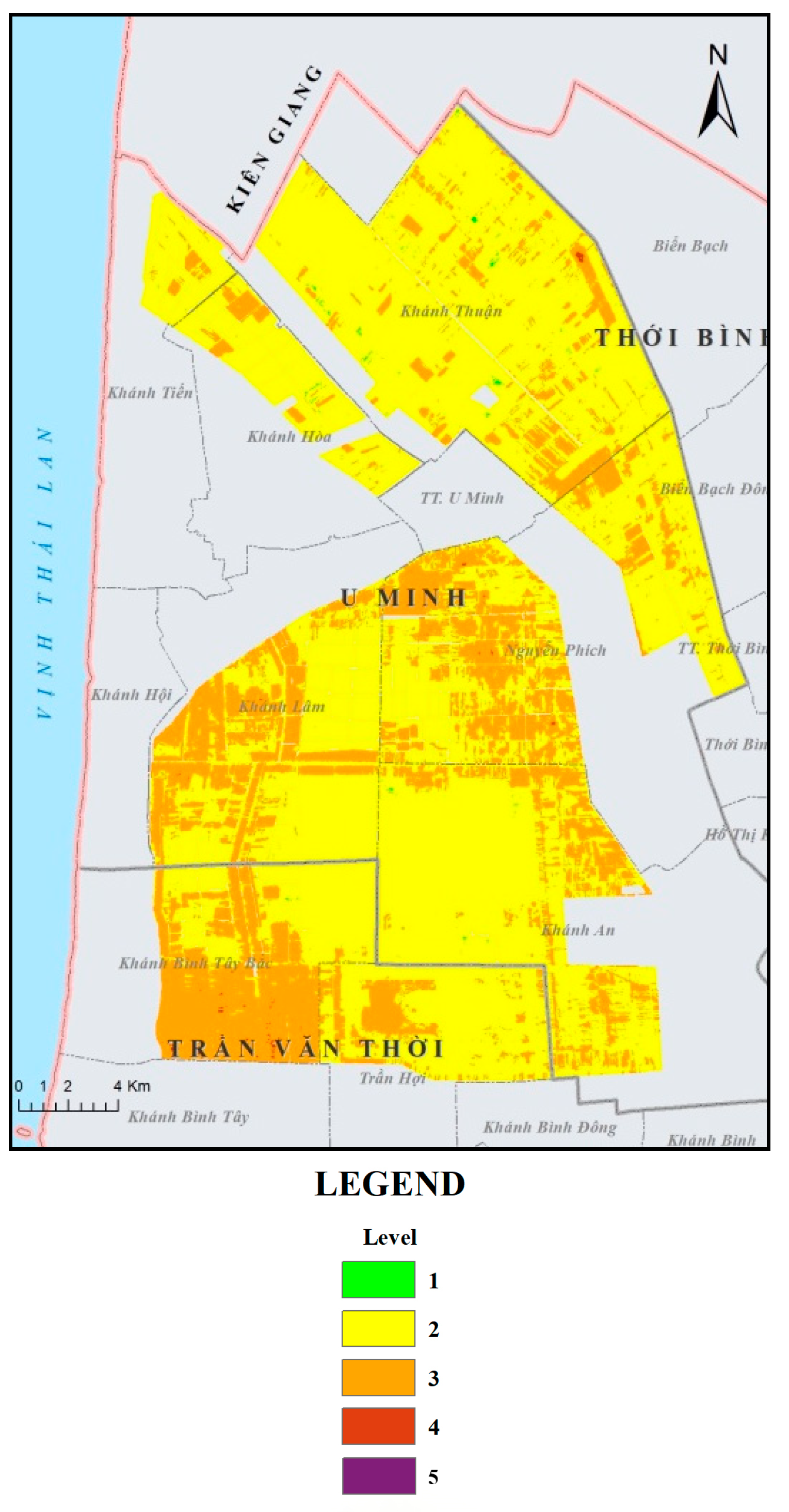Risk of Climate Change Impacts on Drought and Forest Fire Based on Spatial Analysis and Satellite Data †
Abstract
:1. Introduction
2. Methodology
2.1. Data
2.2. Evaluation Method
2.2.1. Normalized Difference Vegetation Index
2.2.2. Normalized Difference Water Index
2.2.3. Land Surface Temperature
2.2.4. Land Cover
2.2.5. Distances to Residential Areas, Water Resources, and Forest Fire Prevention and Fighting Establishments
2.2.6. The Analytic Hierarchy Process and Weight Assignment
3. Results
4. Conclusions
References
- Ca Mau Forest Protection Department. Explanation of Forest Fire Prevention and Fighting Plan in Dry Season 2016–2017 in Ca Mau Province; Ca Mau Forest Protection Department: Ca Mau, Vietnam, 2016. [Google Scholar]
- Ghobadi, G.J.; Gholizadeh, B.; Dashliburun, O.M. Forest fire risk zone mapping from geographic information system in Northern Forests of Iran (Case study, Golestan province). Int. J. Agric. Crop Sci. 2012, 4, 818–824. [Google Scholar]
- Earth Observatory—NASA. Measuring Vegetation (NDVI & EVI): Normalized Difference Vegetation Index (NDVI). Available online: https://earthobservatory.nasa.gov/Features/MeasuringVegetation/measuring_vegetation_2.php (accessed on 5 August 2017).
- Liang, S.; Li, X.; Wang, J. Advanced Remote Sensing: Terrestrial Information Extraction and Applications; Academic Press: Cambridge, MA, USA, 2012. [Google Scholar]
- Zhang, Z.; He, G. Generation of Landsat surface temperature product for China, 2000–2010. Int. J. Remote Sens. 2013, 34, 7369–7375. [Google Scholar] [CrossRef]
- USGS. Landsat 8 (L8) Data Users Handbook. Available online: https://landsat.usgs.gov/landsat-8-l8-data-users-handbook (accessed on 10 February 2016).
- Saaty, T.L. The Analytic Hierarchy Process: Planning, Priority Setting, Resource Allocation; McGraw-Hill International Book Co.: New York, NY, USA, 1980. [Google Scholar]
- Saaty, T.L. Decision Making for Leaders: The Analytical Hierarchy Process for Decisions in a Complex World; Lifetime Learning Publications: Maastricht, The Netherlands, 1982. [Google Scholar]
- Saaty, T.L. Decision making with the analytic hierarchy process. Int. J. Serv. Sci. 2008, 1, 83–98. [Google Scholar] [CrossRef]
- Saaty, T.L.; Alexander, J.M. Conflict Resolution: The Analytic Hierarchy Approach; Praeger: Santa Barbara, CA, USA, 1989. [Google Scholar]
- Saaty, T.L.; Vargas, L.G. Models, Methods, Concepts & Applications of the Analytic Hierarchy Process; Kluwer Academic Publishers: Dordrecht, The Netherlands, 2001. [Google Scholar]


| Variable Layer | ri | ti | wi (%) |
|---|---|---|---|
| Surface temperature | 1 | 7 | 2500 |
| Leaf humidity | 2 | 6 | 2143 |
| Distance to water resource | 3 | 5 | 1786 |
| Distance to forest fire prevention and fighting works | 4 | 4 | 1429 |
| Vegetation density | 5 | 3 | 1071 |
| Land cover type | 6 | 2 | 714 |
| Distance to residence | 7 | 1 | 357 |
| Criteria | Weight % | Sub-Criteria | Point |
|---|---|---|---|
| Distance to residence (m) | 3.57 | 0 ÷ 1000 | 5 |
| 1000 ÷ 2000 | 4 | ||
| 2000 ÷ 3000 | 3 | ||
| 3000 ÷ 4000 | 2 | ||
| Over 4000 | 1 | ||
| Surface temperature (°C) | 25.00 | 43.5 ÷ 47.5 | 5 |
| 39.5 ÷ 43.5 | 4 | ||
| 35.5 ÷ 39.5 | 3 | ||
| 31.5 ÷ 35.5 | 2 | ||
| 27.5 ÷ 31.5 | 1 | ||
| Leaf humidity (NDWI) | 21.43 | −1 ÷ −0.142 | 5 |
| −0.142 ÷ −0.008 | 4 | ||
| −0.008 ÷ 0.125 | 3 | ||
| 0.125 ÷ 0.259 | 2 | ||
| 0.259 ÷ 1 | 1 | ||
| Vegetation density (NDVI) | 10.71 | 0.396 ÷ 1 | 5 |
| 0.259 ÷ 0.396 | 4 | ||
| 0.123 ÷ 0.259 | 3 | ||
| −0.014 ÷ 0.123 | 2 | ||
| −1 ÷ −0.014 | 1 | ||
| Land cover type | 714 | Melaleuca ≥ V, IV | 5 |
| Melaleuca III, II, I | 4 | ||
| Acacia hybrid | 3 | ||
| Agricultural land | 2 | ||
| T0, bare land, residence | 1 | ||
| Distance to forest fire prevention and fighting plan (m) | 1429 | Over 3508 | 5 |
| 2631 ÷ 3508 | 4 | ||
| 1754 ÷ 2631 | 3 | ||
| 877 ÷ 1754 | 2 | ||
| 0 ÷ 877 | 1 | ||
| Distance to water resource (m) | 1786 | Over 1279 | 5 |
| 960 ÷ 1279 | 4 | ||
| 640 ÷ 960 | 3 | ||
| 320 ÷ 640 | 2 | ||
| 0 ÷ 320 | 1 |
| Level | Area (ha) | Ratio (%) |
|---|---|---|
| 1 | 41.58 | 0.08 |
| 2 | 39,115.53 | 73.31 |
| 3 | 14,149.71 | 26.52 |
| 4 | 46.08 | 0.09 |
| 5 | 0 | 0 |
| Tổng | 53,352.90 | 100.00 |
Publisher’s Note: MDPI stays neutral with regard to jurisdictional claims in published maps and institutional affiliations. |
© 2018 by the authors. Licensee MDPI, Basel, Switzerland. This article is an open access article distributed under the terms and conditions of the Creative Commons Attribution (CC BY) license (https://creativecommons.org/licenses/by/4.0/).
Share and Cite
Van, T.T.; Tien, T.V.; Toi, N.D.L.; Bao, H.D.X. Risk of Climate Change Impacts on Drought and Forest Fire Based on Spatial Analysis and Satellite Data. Proceedings 2018, 2, 189. https://doi.org/10.3390/ecws-2-04959
Van TT, Tien TV, Toi NDL, Bao HDX. Risk of Climate Change Impacts on Drought and Forest Fire Based on Spatial Analysis and Satellite Data. Proceedings. 2018; 2(5):189. https://doi.org/10.3390/ecws-2-04959
Chicago/Turabian StyleVan, Tran Thi, Tran Viet Tien, Nguyen Duong Lam Toi, and Ha Duong Xuan Bao. 2018. "Risk of Climate Change Impacts on Drought and Forest Fire Based on Spatial Analysis and Satellite Data" Proceedings 2, no. 5: 189. https://doi.org/10.3390/ecws-2-04959





